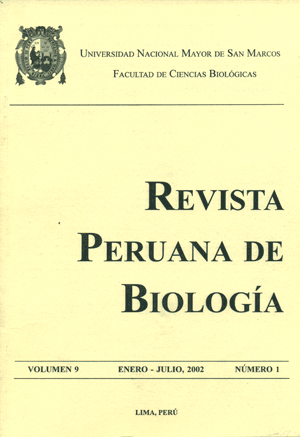Absortion of iron in "Maca" lepidium meyenii walp. (Brasicaceae)
DOI:
https://doi.org/10.15381/rpb.v9i1.2513Keywords:
Lepidium meyenii, ¨maca¨, iron, iron absorption, FeAbstract
Lepidium meyenii Walp. (Brasicaceae) “maca” is an Andean plant appreciated for its hypocotil which has high medical and nutritional value, and among these, its high iron content. In order to test the possibility of increasing the iron content, an experiment was carried out at greenhouse conditions in Lima, Peru, from May to November 1999, in which solutions containing three levels of natural iron (5, 15 and 25 ppm) were used to grow maca. Seeds of accession ARB5441 (CIP) were used. The iron content was measured after 50 and 179 days of treatment (dat) by the phenantroline method. Meaningful differences were found in the iron content in leaves and the hypocotil after 50 dat, which increased with the concentration of iron in the solutions, whereas at 179 this trend was noticed only for leaves. The concentration of iron in the hypocotil for each treatment do not increase in time whereas the opposite is observed in the leaves. In general, the concentration of iron obtained in the experiment is higher than that observed in plants grown under natural conditions.The weight of the plant tends to decrease when increasing the concentration of iron in the solution at 50 dat, whereas the opposite trend was observed at 179 ddt. The weight of the hypocotils increased noticeably as a function of time, whereas that of the leaves showed only a slight increase.Downloads
Downloads
Published
Issue
Section
License
Copyright (c) 2002 Mery L. Suni, Jorge A. Bravo, Julio x Fabián S.

This work is licensed under a Creative Commons Attribution-NonCommercial-ShareAlike 4.0 International License.
AUTHORS RETAIN THEIR RIGHTS:
a. Authors retain their trade mark rights and patent, and also on any process or procedure described in the article.
b. Authors retain their right to share, copy, distribute, perform and publicly communicate their article (eg, to place their article in an institutional repository or publish it in a book), with an acknowledgment of its initial publication in the Revista Peruana de Biologia.
c. Authors retain theirs right to make a subsequent publication of their work, to use the article or any part thereof (eg a compilation of his papers, lecture notes, thesis, or a book), always indicating its initial publication in the Revista Peruana de Biologia (the originator of the work, journal, volume, number and date).






